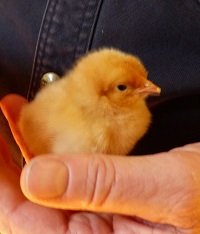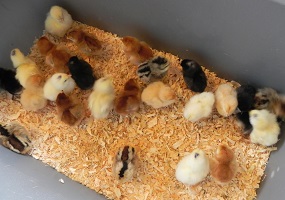In the past few years, thousands of Americans have begun tending small flocks of chickens in their backyards. For most folks, it’s a new hobby, but we’ve been at it far longer. Rich began raising chickens in his suburban backyard when he was eight or nine years old – over 60 years ago. Marion’s family raised chickens at their New Hampshire home.
This spring many chicken newcomers will install a coop, raise chicks, and produce delicious food in their yards. It can be complicated, so this blog is designed to explain chicken husbandry in its very simplest form. Many books in most libraries and websites on chicken culture give detailed chicken care information and are outstanding resources. We recommend checking Hoover’s Hatchery. It offers a printed catalog, an online catalog, and website blogs. We also do a Facebook Live program each month for Hoover’s about different aspects of chicken care. Also see Scoop from the Coop for detailed information.
Chicks

Baby chicks can be purchased on line.
Baby chicks can be purchased online. Most hatcheries require a minimum order of 15 or 25 babies, usually more than most families want. Smaller quantities can be purchased at farm stores, such as Tractor Supply. Many cities have ordinances allowing chickens but usually limit the flock size to six or fewer birds. Check your local ordinance before buying.
Chicks come in dozens of different breeds, but we suggest choosing those that lay brown eggs. These breeds are fairly large bodied, calm birds. Our long-term favorites are New Englanders like the Rhode Island or New Hampshire Reds, or the Barred Plymouth Rock. Other great breeds are Wyandottes, Orpingtons, and Australorps. White egg breeds, like Leghorns, lay like crazy but are more nervous and noisier than brown eggers.
Often, it’s possible to buy a variety of breeds. Having a six hen flock composed of six different breeds is colorful and fun.
Housing

Chicks need to be warm until their insulating feather grow.
Baby chicks need to be warm until their insulating feathers grow. They are reared in a device called a brooder. A simple one can be made with items most people have around the house. See the blog on building a brooder on Hoover’s Hatchery Website for detail.
By the time the babies are six weeks, or so, old they need to move into permanent quarters, the chicken coop. The easiest way for a family to start is to buy a pre-made coop online or at a farm store. These range in size from tiny ones that will fit just a couple of hens to those that might fit up to a dozen. It’s a good idea to have an attached outside fenced in area, called a run, so the hens can enjoy fresh air and sunshine. Building a coop isn’t difficult and plans are printed in most basic chicken books or can be downloaded from websites.
Chicken houses need fluffy bedding, called litter, covering the floor. Pine chips work great. Bales of chips can be bought at farm stores. Every coop should have a nest for hens to lay their eggs in and a pole installed parallel to the floor for them to roost on. Yup, chickens sleep standing up.
The house should have windows that can be closed to prevent cold winter drafts but open to welcome fresh summer air. Cover windows with mosquito mesh and heavy wire to discourage both bugs and raccoons. Neighborhood raccoons would love a chicken dinner, so keep them out of the coop!
Food and Drink
Stores that sell baby chicks almost always sell feed. Babies need a high protein mash called Chick Starter from the time they hatch until they lay their first egg. Then switch to Layer feed. Simple inexpensive feeders are sold in farm stores. Chickens love drinking fresh water so invest in a water fount and keep it full. Hens enjoy a handful of corn every once in a while, as a treat. They also love table scraps. We give ours bits of rice, squash seeds and hulls, meat scraps and a few other things. As with all treats, we keep portions small.
The Nutshell

Raising chickens helps kids learn care and responsibility.
This is chicken husbandry in a nutshell. There’s lots more to it, so be sure to read websites and books on chicken care before buying your first batch of chicks. If you are lucky you can take a backyard chicken basic class at a nearby nature or garden center.

